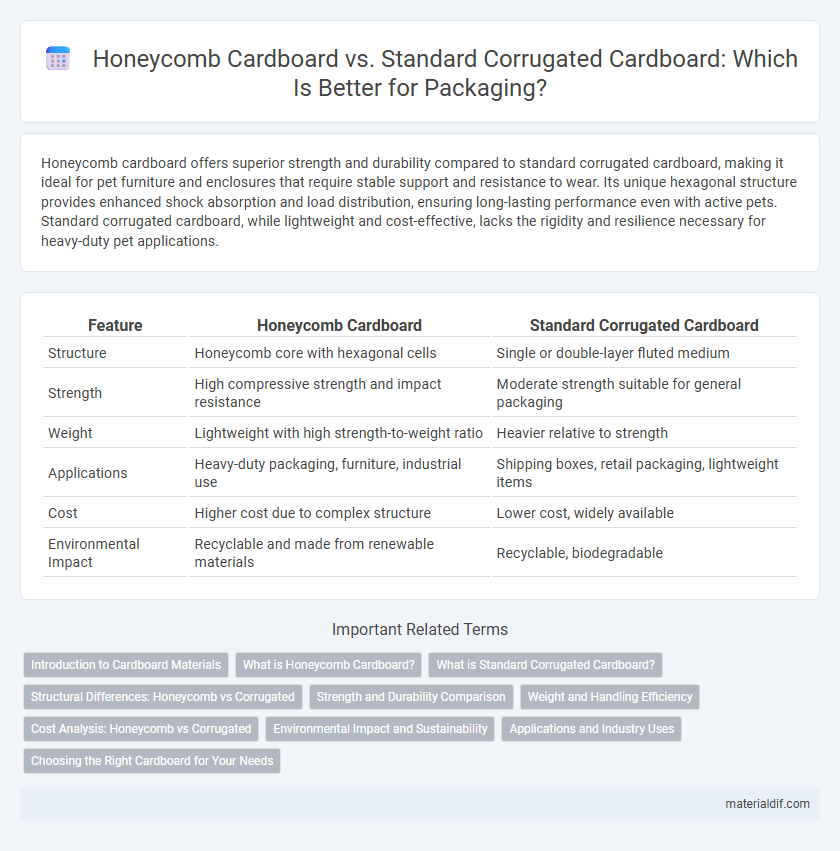Honeycomb cardboard offers superior strength and durability compared to standard corrugated cardboard, making it ideal for pet furniture and enclosures that require stable support and resistance to wear. Its unique hexagonal structure provides enhanced shock absorption and load distribution, ensuring long-lasting performance even with active pets. Standard corrugated cardboard, while lightweight and cost-effective, lacks the rigidity and resilience necessary for heavy-duty pet applications.
Table of Comparison
| Feature | Honeycomb Cardboard | Standard Corrugated Cardboard |
|---|---|---|
| Structure | Honeycomb core with hexagonal cells | Single or double-layer fluted medium |
| Strength | High compressive strength and impact resistance | Moderate strength suitable for general packaging |
| Weight | Lightweight with high strength-to-weight ratio | Heavier relative to strength |
| Applications | Heavy-duty packaging, furniture, industrial use | Shipping boxes, retail packaging, lightweight items |
| Cost | Higher cost due to complex structure | Lower cost, widely available |
| Environmental Impact | Recyclable and made from renewable materials | Recyclable, biodegradable |
Introduction to Cardboard Materials
Honeycomb cardboard features a unique hexagonal core structure that provides superior strength-to-weight ratio compared to the fluted layers of standard corrugated cardboard. This innovative design offers enhanced load-bearing capacity and cushioning properties, making it ideal for heavy-duty packaging and protective applications. Standard corrugated cardboard remains popular for general-purpose packaging due to its cost-effectiveness and ease of manufacturing.
What is Honeycomb Cardboard?
Honeycomb cardboard features a unique core structure made of hexagonal cells that provide exceptional strength and lightweight properties compared to standard corrugated cardboard. This design offers superior load-bearing capacity, impact resistance, and cushioning, making it ideal for heavy-duty packaging and industrial applications. Honeycomb cardboard's efficient material usage results in enhanced durability while reducing overall weight and environmental impact.
What is Standard Corrugated Cardboard?
Standard corrugated cardboard consists of a fluted corrugated sheet sandwiched between two flat linerboards, providing durability and cushioning for packaging applications. It is widely used for shipping boxes and protective packaging due to its strength, lightweight nature, and cost-effectiveness. The fluted structure enhances rigidity and resistance to impact, making it ideal for stacking and transporting goods safely.
Structural Differences: Honeycomb vs Corrugated
Honeycomb cardboard features a hexagonal, honeycomb-shaped core that provides superior strength and lightweight properties compared to the fluted inner layer of standard corrugated cardboard. The honeycomb core distributes weight evenly and absorbs impact more efficiently, enhancing durability and load-bearing capacity. Standard corrugated cardboard consists of one or more fluted layers sandwiched between linerboards, offering flexibility but less resistance to compression than honeycomb structures.
Strength and Durability Comparison
Honeycomb cardboard features a unique hexagonal core structure that provides superior strength and durability compared to standard corrugated cardboard, which relies on a fluted layer between two liners. This honeycomb design offers enhanced load-bearing capacity and resistance to crushing, making it ideal for heavy-duty packaging and furniture applications. Standard corrugated cardboard, while cost-effective and lightweight, generally exhibits lower resistance to impact and compression under prolonged stress.
Weight and Handling Efficiency
Honeycomb cardboard is significantly lighter than standard corrugated cardboard, reducing transportation costs and easing manual handling processes. Its unique hexagonal core structure offers superior strength-to-weight ratio, enhancing packing efficiency without compromising durability. This weight advantage improves loading and unloading speeds, making honeycomb cardboard ideal for logistics operations requiring swift material movement.
Cost Analysis: Honeycomb vs Corrugated
Honeycomb cardboard generally offers a higher initial cost compared to standard corrugated cardboard due to its more complex manufacturing process and use of stronger materials. However, honeycomb panels provide superior strength-to-weight ratio and durability, which can reduce transportation and handling costs over time. When evaluating total cost of ownership, honeycomb cardboard often proves more economical for applications requiring enhanced load-bearing capacity and damage resistance.
Environmental Impact and Sustainability
Honeycomb cardboard features a unique structure made from recycled paperboard, optimizing material use and significantly reducing carbon footprint compared to standard corrugated cardboard. Its lightweight design enhances fuel efficiency during transportation, leading to lower greenhouse gas emissions and less environmental strain. The honeycomb core's recyclability and biodegradability contribute to sustainable packaging solutions by minimizing landfill waste and promoting circular economy practices.
Applications and Industry Uses
Honeycomb cardboard offers superior strength-to-weight ratio, making it ideal for automotive, aerospace, and furniture packaging applications where durability and lightweight materials are critical. Standard corrugated cardboard remains widely used in retail packaging, shipping boxes, and consumer goods due to its cost-effectiveness and ease of recycling. Industries requiring robust, impact-resistant solutions prefer honeycomb cardboard for protective packaging, while standard corrugated cardboard suits high-volume, general-purpose packaging needs.
Choosing the Right Cardboard for Your Needs
Honeycomb cardboard offers superior strength-to-weight ratio and enhanced cushioning compared to standard corrugated cardboard, making it ideal for heavy-duty packaging and protective applications. Standard corrugated cardboard is more cost-effective and widely available, suitable for lightweight items and everyday shipping needs. Selecting the right cardboard depends on factors such as load-bearing requirements, cost considerations, and environmental impact, ensuring optimal protection and sustainability.
Honeycomb cardboard vs Standard corrugated cardboard Infographic

 materialdif.com
materialdif.com